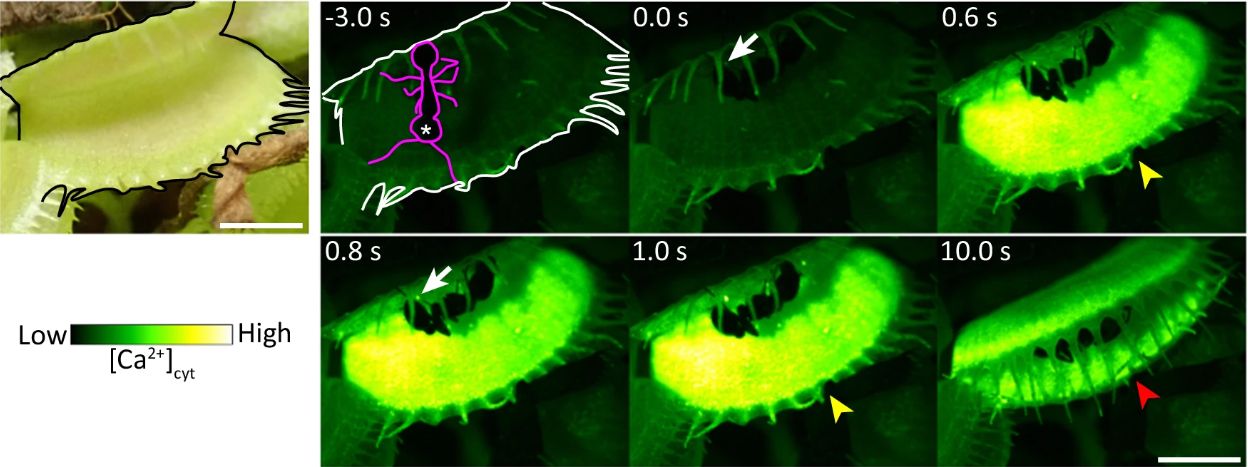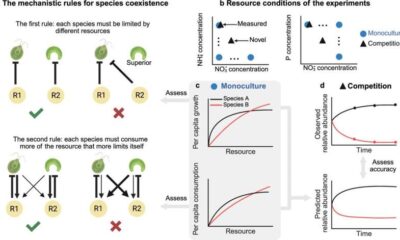Science
New Mechanosensor Unveiled in Venus Flytrap’s Rapid Response

Research has identified a new mechanosensor that plays a crucial role in the rapid response of the Venus flytrap (Dionaea muscipula) to prey. In a study published in Nature Communications, lead researcher Hiraku Suda and colleagues reveal the significance of a specific protein, named DmMSL10, in the plant’s ability to detect and respond to stimuli.
The Venus flytrap, renowned for its spring-loaded trap, relies on sensory hairs lining its leaves to trigger a response when they detect movement. Previous studies had established that the plant utilizes calcium threshold signals to facilitate this rapid reaction, but the underlying mechanism remained unclear.
Researchers bred a variant of the Venus flytrap lacking the DmMSL10 protein, a stretch-activated chloride ion (Cl–) channel. The results showed that while both the wild-type and knockout plants experienced calcium ion release from mechanical stimulation, the rate of action potential generation was significantly lower in the knockout variant. The wild-type plants continued to generate action potentials even after the initial stimulation ceased, demonstrating the essential role of DmMSL10 in prey detection.
In a follow-up experiment, the team observed the behavior of ants on both the wild-type and knockout plants. The wild-type plant successfully captured the first ant that wandered onto its leaf, while the knockout variant remained unresponsive as multiple ants failed to trigger sufficient calcium signals to close the trap.
This research provides valuable insight into the mechanisms that allow the Venus flytrap to effectively capture prey, which are rich in protein and nitrogen. The findings also suggest potential evolutionary parallels between the mechanisms of plant and animal sensory responses.
The study enhances our understanding of plant biology and opens avenues for further exploration into how such rapid response systems evolved. The implications of this research stretch beyond the Venus flytrap, potentially impacting our understanding of similar mechanisms in other plant species, such as the waterwheel plant (Aldrovanda vesiculosa), and even in the animal kingdom.
-

 Technology5 months ago
Technology5 months agoDiscover the Top 10 Calorie Counting Apps of 2025
-

 Health2 months ago
Health2 months agoBella Hadid Shares Health Update After Treatment for Lyme Disease
-

 Health3 months ago
Health3 months agoErin Bates Shares Recovery Update Following Sepsis Complications
-

 Technology4 months ago
Technology4 months agoDiscover How to Reverse Image Search Using ChatGPT Effortlessly
-

 Technology1 month ago
Technology1 month agoDiscover 2025’s Top GPUs for Exceptional 4K Gaming Performance
-

 Technology2 months ago
Technology2 months agoElectric Moto Influencer Surronster Arrested in Tijuana
-

 Technology5 months ago
Technology5 months agoMeta Initiates $60B AI Data Center Expansion, Starting in Ohio
-

 Technology5 months ago
Technology5 months agoRecovering a Suspended TikTok Account: A Step-by-Step Guide
-

 Health4 months ago
Health4 months agoTested: Rab Firewall Mountain Jacket Survives Harsh Conditions
-

 Lifestyle5 months ago
Lifestyle5 months agoBelton Family Reunites After Daughter Survives Hill Country Floods
-

 Technology4 months ago
Technology4 months agoHarmonic Launches AI Chatbot App to Transform Mathematical Reasoning
-

 Technology3 months ago
Technology3 months agoUncovering the Top Five Most Challenging Motorcycles to Ride





















